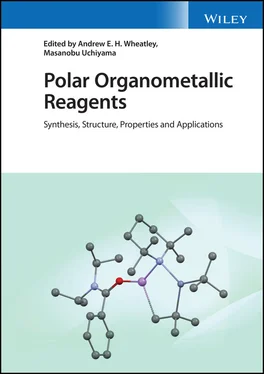Polar Organometallic Reagents
Здесь есть возможность читать онлайн «Polar Organometallic Reagents» — ознакомительный отрывок электронной книги совершенно бесплатно, а после прочтения отрывка купить полную версию. В некоторых случаях можно слушать аудио, скачать через торрент в формате fb2 и присутствует краткое содержание. Жанр: unrecognised, на английском языке. Описание произведения, (предисловие) а так же отзывы посетителей доступны на портале библиотеки ЛибКат.
- Название:Polar Organometallic Reagents
- Автор:
- Жанр:
- Год:неизвестен
- ISBN:нет данных
- Рейтинг книги:5 / 5. Голосов: 1
-
Избранное:Добавить в избранное
- Отзывы:
-
Ваша оценка:
- 100
- 1
- 2
- 3
- 4
- 5
Polar Organometallic Reagents: краткое содержание, описание и аннотация
Предлагаем к чтению аннотацию, описание, краткое содержание или предисловие (зависит от того, что написал сам автор книги «Polar Organometallic Reagents»). Если вы не нашли необходимую информацию о книге — напишите в комментариях, мы постараемся отыскать её.
Polar Organometallic Reagents
Polar Organometallic Reagents
Polar Organometallic Reagents — читать онлайн ознакомительный отрывок
Ниже представлен текст книги, разбитый по страницам. Система сохранения места последней прочитанной страницы, позволяет с удобством читать онлайн бесплатно книгу «Polar Organometallic Reagents», без необходимости каждый раз заново искать на чём Вы остановились. Поставьте закладку, и сможете в любой момент перейти на страницу, на которой закончили чтение.
Интервал:
Закладка:
Following the introduction of convenient spectroscopic handles in Chapter 5, multinuclear NMR studies allow the interrogation of solution processes and intermediates in Chapter 6. This picks up ideas hinted at but not fully explored in Chapters 1– 3. The chapter revisits early studies in the NMR spectroscopic analysis of recognizably traditional organolithium and lithium amide systems, but then brings that work up‐to‐date, looking at the recent elegant advances in our understanding of the solution dynamics of enolates. The main focus of this chapter, though, relates to recent developments in diffusion‐ordered spectroscopy. Again, this is contextualized though reference to the early work of Williard, but then shifts to modern lithium amide chemistry capable of being done under aerobic conditions. Most particularly, though, modern diffusion methods have allowed us to better understand the real solution chemistries of heterobimetallic formulations. This has been greatly enabled by the work of Stalke, raising the bar where the accuracy of molecular weight determination in solution is concerned. In consequence, diffusion analysis and multinuclear spectroscopy has prompted a much truer understanding of the aggregation and solvation of highly applied systems—for example the turbo reagents of Knochel.
The final set of chapters deal with up‐to‐date aspects of (mostly main group) synthetic applications of organometallic and metalloorganic chemistry. Chapter 7is focused on the chemistry of boryl anions. In these, the nucleophilicity at the group 13 centre contrasts with the more common Lewis acid chemistry of boron, enabling a range of boryl‐substituted organic, main group, and organometallic compounds to be prepared. Chapter 8deals very much with synthetic organic chemistry as accessed by ate complexes. A range of ate complexes are discussed, but the chapter opens, appropriately enough, with work done in Sendai in the early 1990s. Initial discussion of sterically demanding tetramethylzincate in a range of transformations eventually shifts to the advent of organoamidozincates that are structurally covered in earlier chapters. From there, the evolution of aluminate and cyanocuprate congeners follows naturally. Again, structural aspects of these species feature elsewhere, but the discussion here focuses on their potential in aromatic derivatization. The chapter also continues a theme from the previous one. Efforts to exert control over the reactivity of boryl anions through ate complexes are presented in the context of novel nucleophilic boration. Lastly, Chapter 9finishes the book as it started, looking at organocopper compounds. Copper‐mediated processes are well established, prompting much organocopper structural chemistry. Whereas efforts have often focused on alkynyl‐ and arylorganocopper complexes, the emphasis here is instead on traditionally unstable mono‐alkenyl and butadienylcopper compounds. The potential of steric, coordinative and synergistic strategies for preventing decomposition are examined.
Overall, this book seeks to bring the reader up‐to‐date with developments in the field of modern polar organometallic chemistry, particularly in the context of the emergent areas of synergic and cooperative species. The recent advances in our understanding of the operation of these systems are presented, but the evolution of the area is described, offering a context and explaining the need and rationale for the advent of new reagents. The hope is that this is done in a way that makes the text accessible to students as well as academics and industrial scientists, arming them with a broad understanding of how these systems present new opportunities to the synthetic chemist.
A. E. H. Wheatley Cambridge, UK
M. Uchiyama Tokyo, Japan
List of Contributors
Alistair M. Broughton Yusuf Hamied Department of Chemistry University of Cambridge Cambridge, UK
Andrew E. H. Wheatley Yusuf Hamied Department of Chemistry University of Cambridge Cambridge, UK
Andrew J. Peel Yusuf Hamied Department of Chemistry University of Cambridge Cambridge, UK
Andrew S. S. Wilson Department of Chemistry University of Bath Claverton Down, UK
Anne‐Frédérique Pécharman Department of Chemistry University of Bath Claverton Down, UK
Antoine Buchard Department of Chemistry University of Bath Claverton Down, UK
Chao Wang Graduate School of Pharmaceutical Sciences The University of Tokyo Tokyo, Japan
Eva Hevia Department für Chemie, Biochemie und Pharmazie Universität Bern Bern, Switzerland
Frances N. Singer Department of Chemistry University of Bath Claverton Down, UK
Keiichi Hirano Graduate School of Pharmaceutical Sciences The University of Tokyo Tokyo, Japan
Leonie J. Bole Department für Chemie, Biochemie und Pharmazie Universität Bern Bern, Switzerland
Liang Liu College of Chemistry Peking University Beijing, China
Makoto Yamashita Department of Molecular and Macromolecular Chemistry Graduate School of Engineering Nagoya University Nagoya, Japan
Mamta Bhandari Department of Chemical Sciences Indian Institute of Science Education and Research Mohali India
Masanobu Uchiyama Graduate School of Pharmaceutical Sciences The University of Tokyo Tokyo, Japan
Research Initiative for Supra‐Materials (RISM)
Shinshu University
Nagano, Japan
Masanori Shigeno Graduate School of Pharmaceutical Sciences Tohoku University Sendai, Japan
Michael S. Hill Department of Chemistry University of Bath Claverton Down, UK
Robert E. Mulvey WestCHEM, Department of Pure and Applied Chemistry University of Strathclyde Glasgow, UK
Sandeep Rawat Department of Chemical Sciences Indian Institute of Science Education and Research Mohali India
Sanjay Singh Department of Chemical Sciences Indian Institute of Science Education and Research Mohali India
Sharanappa Nembenna School of Chemical Sciences National Institute of Science Education and Research Bhubaneswar India
Stuart D. Robertson WestCHEM, Department of Pure and Applied Chemistry University of Strathclyde Glasgow, UK
Yoshinori Kondo Graduate School of Pharmaceutical Sciences Tohoku University Sendai, Japan
Zhenfeng Xi College of Chemistry Peking University Beijing, China
Acknowledgements
The editors wish to thank John Wiley & Sons for the opportunity to publish this work. Our sincere thanks go to Sarah Higginbotham for proposing and supporting the idea of a book covering the recent advances in the field of polar organometallics. We are also grateful to Emma Strickland and the handling editors, particularly Katrina Maceda, for their constant support and advice. Finally, we would thank the chapter authors for contributing their expertise and time, without which this book could not have happened.
1 The Road to Aromatic Functionalization by Mixed‐metal Ate Chemistry
Masanori Shigenoa, Andrew J. Peelb, Andrew E. H. Wheatleyb, and Yoshinori Kondoa
a Graduate School of Pharmaceutical Sciences, Tohoku University, Sendai, Japan
b Yusuf Hamied Department of Chemistry, University of Cambridge, Cambridge, UK
1.1 Introduction
Multifunctionalized organometallic species have played a vital role as versatile intermediates in modern synthetic organic chemistry for many years [1, 2]. Identifying a suitable metal and controlling reaction conditions have been crucial to underpinning the handling of functionalized organometallics because the reactivity and stability of these species and the effectiveness, selectivity, and safety of the process(es) by which they display metalation are strongly dependent upon the identity of the metal. This chapter describes the advent of controlled and selective metalation using traditional monometallic reagents but also outlines its limitations and the recognition that reactivity can be tuned by introducing a second metal centre. It was this view that eventually gave rise to a major theme of the current book; the concept of ate complexation of organometallics containing a very electropositive (highly reactive but perhaps unselective) metal using a more electronegative (less reactive, more selective) metal ( Figure 1.1a). This idea led, in the late 1990s, to the use of not only organozinc halides or di‐organozincs but also of the development of organozincates and their extensive use in a range of organic transformations including nucleophilic addition, halogen–metal exchange, metal carbenoid synthesis, de‐protonative metalation, ring‐opening, and cross‐coupling [3]. The prolific ability of organozinc compounds and complexes to effect efficient yet highly selective transformations in tandem with inherent functional group compatibility resulted in great interest from synthetic chemists. In particular, because the latter characteristic feeds into applications in directed aromatic metalation, whereby a pre‐existing substituent on an aromatic ring acts as a directing group (DMG) to promote selective reaction. This is a methodology that has come to represent one of the most effective ways of regiospecifically elaborating functionalized aromatic systems and which has, over a number of years, focused on the strategy of achieving ortho reaction of said ring. Though this technique has come to the fore in the elaboration of both aromatic and heteroaromatic systems, the low acidity of the hydrogen atoms on aromatic rings has led to a dependence on organolithium reagents as the base of choice for effecting deprotonation [4–8]. However, the high nucleophilicity of these same organolithium reagents has brought with it the associated risk of competing reaction at the DMG itself. It was the need to overcome this synthetic limitation that led to the development of the heterobimetallic complexes alluded to above, designed to promote chemoselective directed metalation reactions under mild conditions on the grounds of reduced nucleophilicity. This has now seen a range of zincates and other metal ate complexes incorporating the sterically bulky (non‐nucleophilic) 2,2,6,6‐tetramethylpiperidide ligand (TMP) successfully used to elaborate functionalized aromatics incorporating DMGs normally susceptible to competing nucleophilic degradation. The first work in this field appeared in 1999 when Kondo and coworkers reported the directed zincation of a functionalized aromatic compound. This was achieved using the, at that stage, putative base t ‐Bu 2Zn(TMP)Li 1( Figure 1.1b and Scheme 1.1) and avoided the normal (for organolithium reagents) requirement of temperatures below room temperature (r.t.) [9]. This key advance led to an explosion of interest in developing the concept of tunable ate complex reagents in directed metalation chemistry.
Читать дальшеИнтервал:
Закладка:
Похожие книги на «Polar Organometallic Reagents»
Представляем Вашему вниманию похожие книги на «Polar Organometallic Reagents» списком для выбора. Мы отобрали схожую по названию и смыслу литературу в надежде предоставить читателям больше вариантов отыскать новые, интересные, ещё непрочитанные произведения.
Обсуждение, отзывы о книге «Polar Organometallic Reagents» и просто собственные мнения читателей. Оставьте ваши комментарии, напишите, что Вы думаете о произведении, его смысле или главных героях. Укажите что конкретно понравилось, а что нет, и почему Вы так считаете.












